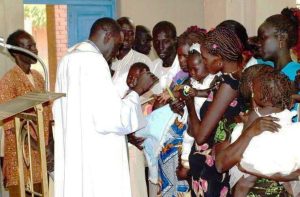The Nuer are a tribe of South Sudan numbering about two million people. It comprises four sections – Nuer-Bentiu, Nuer-Fangak, Nuer-Ikany and Nuer-Lou. We look at the traditional marriage among the Nuer-Gawar that belongs to the Nuer-Fangak.
When the boy expresses his desire to get married and it’s agreed upon in the family, he makes the proposal to the girl. If she says no resolutely, the boy forgets about her. If she agrees, she will not say ‘yes’ openly. She will rather tell him that she will think about it, that she is too young, and that she is not thinking of marrying yet. Actually, she knows that marriage is not a private business but it concerns the two families. She wants to share the boy’s proposal with her family and friends first. She wants to know how serious the proposal is and even to know the boy better. In the end, she tells him to return another day. At this point, the boy knows that the girl accepts and the two will speak to their families.
Meanwhile, the two families activate themselves to get all the information they need. If they find out elements against the marriage, the boy will not return or will tell the girl that he has to make a long journey. The girl will then resolutely say ‘no’ to the boy’s proposal. And the case is closed.
The family of the boy wants to know if the girl is serious, discrete, responsible, a hard worker, house loving. If she is a student, they want to know if she enjoys a good name. In the case that her family is a family given to witchcrafts, this is considered a negative factor.
On the other hand, the family of the girl wants to know if the boy has a good character, is a hard worker, is not a thief or son of thieves, and is responsible, even if he does not have a large number of cows. Both families will consider if there are good relations between the two families, no enmity, no killing. At this point a prominent relative for each family accepts to be guarantor, so that the agreement be worked out.
The boy, accompanied by his brothers and friends, but not by his father, goes to the house of the girl, and waits outside at a certain distance. When the girl – who has been previously informed – sees them, she tells her father who, in turn, tells her to let them in. But the girl remains outside.
Once the visitors are inside, nothing is offered to them, not even water. The father of the girl deals at once with the issue. Meanwhile, other relatives join in. They go back to the pieces of information they already know for confirmation, especially the issue of blood relation among the two, and then if there has been killing or enmity (cuak) among the two families. Then they touch the issue of the dowry, which will be fully dealt with at a later date. The boy will behave as well as he can and show respect to the father of the girl. He knows that the girl will do according to her father’s will. At the end, the father of the girl will tell the boy that he is happy that he marries her daughter and tells him to prepare for marriage. Normally, he is given one week for the preparation. On the way back home, the boy and his friends will sing and dance both to express their happiness and at the same time to announce that the celebration of marriage has started.
Soon after, the women of the girl’s family will go around with her, singing and dancing, to invite the relatives to be ready to participate in the celebration. The women of the boy’s family, accompanied by the boy and his brothers and friend, will do the same.
After seven days, the boy, his family – excluding the father – and his friends, will go to the house of the girl and will offer some cows to her family, as part of the dowry. The family of the girl will kill a bull for the occasion. The visitors will remain there for a week, eating, drinking, singing and dancing. At the end the father of the girl tells the boy the date of the final rite of marriage. For that occasion the boy must also bring his father. At that point, the two families will go around again to invite the relatives.
On the fixed day, all the boy’s family and his friends go to the house of the girl in a festive mood, leading the required cows. They will find the relatives of the girl waiting for them. After greeting each other, the people will celebrate by eating and dancing till late at night. The following day the issue of the dowry is finalised. In the past the cows requested used to be 25, at present they are 50 or even a 100.
Early morning, all enter the stable – the luak. The family of the girl sits on one side, the relatives of the boy on the opposite side. The father of the girl sits slightly separated, to mark his particular position at that moment. Two witnesses are invited to help, one for each family.
When the cows are brought in, the father of the girl will suggest to the boy not to pay all of them, but to keep two or three to be brought later. Once the cows are given, the father asks the girl if she is ready to pass to the family of the boy. After her consent, she will leave her group and join the group of the family of the boy which welcomes her with joy.
Before leaving, the boy and his father ask the father of the girl when they may send to take the girl. The father of the girl will specify the time. Once they have agreed, all go. The girl will remain in her own family. When the day comes, the women – friends and neighbours – will accompany her to the house of the husband with songs and dances along the way. Meanwhile in the courtyard of the husband’s house people gather to welcome the wife and her group with songs and dances.
At around midday the sisters of the husband bring the girl in front of the women. They undress her and dress her with a special skirt – a yiet. There are four of them. One is to express the reaching of womanhood. At the end, the same women who have accompanied the girl to the house of the husband will accompany her back to the house of her father. The father will assign a special hut to her, a bit isolated. There she will receive the visits of the husband starting a couple of days later and consummate the marriage.
After some time, the father of the girl will allow the husband to take the wife to his home. Before going she will prepare food and milk to take with her and one day, accompanied by her younger sister and a couple of friends, she goes to the house of the husband, carrying her property and the food prepared. The father-in-law or the eldest brother of the husband will distribute the milk and the food brought by the woman. Meanwhile the husband will inform relatives and friends that the wife is now in his house and that she, on such a day, will cook for all and there will be a feast.
The husband kills a bull for the occasion, in order to celebrate as well as to give a chance to the wife to cook and show her ability. After the girl has spent some days in the house of the husband, the relatives of the husband will visit the family of the wife, also taking with them milk and food and will remain there in friendly relations.
The way marriage is celebrated shows how much the ‘pastoralist’ culture is still present among the Nuer. They are convinced that these traditions will help the tribe to keep its identity and, as a consequence, its unity. The union of two families will strengthen the people’s ties more and more.
– Antonio La Braca








